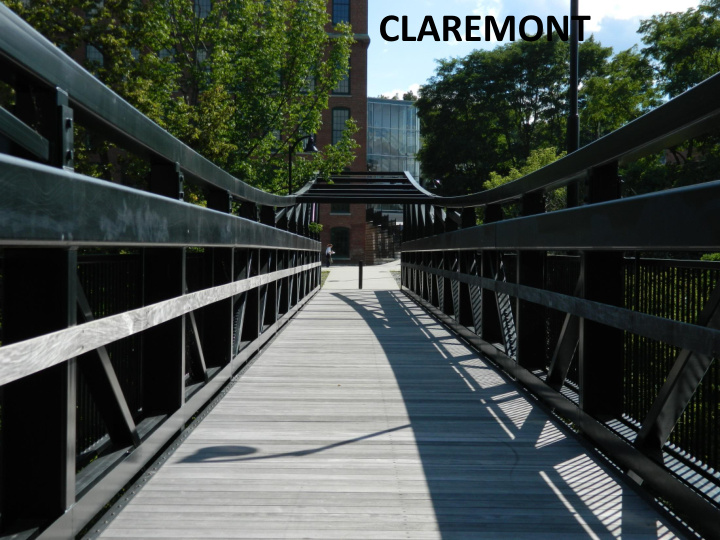



CLAREMONT
Embracing the City Center
City Center Project Economic Development • Encourage entertainment, culture, and arts • Mixed-use buildings emphasizing street-level commercial uses • Establish mixed-use corridors • Allow higher density residential uses (matching existing housing) • Reinvestment and adaptive reuse of existing buildings
Neighborhoods • Retain and reinforce neighborhood character • Encourage neighborhood-scale stores • Allow higher density residential uses-match existing densities where appropriate
Regulatory Barriers • Streamline and simplify permitting • Minimize existing nonconforming buildings • Allow desirable uses not listed in the Zoning
City Center Initiatives 2014-2015
Implementation • Updated signage ordinance • Main Street Road & Sidewalk Project • Safe Routes to Schools • Parking audit; utilization • Energy - Hot Water Heating District • Sale and Rehab of existing buildings – Sawtooth, old Armory
Preferences among the Millennial Generation Various Sources – Compiled April 2015 Millennial Housing Preferences: “A new ULI survey of about 1,200 Millennials shows that 59 percent of those surveyed prefer a home in a neighborhood that has a variety of housing types. For example, 62 percent said they prefer mixed-use developments with shops, restaurants, and offices, and 52 percent say they like pedestrian- friendly neighborhoods.” http://realtormag.realtor.org/daily-news/2013/05/23/millennials-show-preference- for-compact-urban-homes Millennial Work Preferences: “When it comes to work, Millennials are mostly similar to previous generations: they want to be successful, and they want the type of prosperity that means that their children will be better off. They are somewhat more likely than previous generations to report that they consider creativity to be a very important job feature.” (p. 10) https://www.whitehouse.gov/sites/default/files/docs/millennials_report.pdf
Millennial Shopping Preferences “This desire for authenticity, tied to localism and regional pride in the products they buy is also seen in changes to product packaging. The micro-labeling trend shows the desire for a sense of community pride, as well as education on where goods are produced .” http://www.nielsen.com/content/dam/corporate/us/en/reports- downloads/2014%20Reports/nielsen-millennial-report-feb-2014.pdf (p. 31) Impact of Arts on NH Economy “ Arts & Economic Prosperity IV provides compelling new evidence that the nonprofit arts and culture sector is a significant industry in the State of New Hampshire — one that, based upon responses received to this survey, generates $115.1 million in total economic activity. This spending — $53 million by nonprofit arts and culture organizations and an additional $62.1 million in event-related spending by their audiences — supports 3,493 full-time equivalent jobs, generates $79.5 million in household income to local residents, and delivers $11.6 million in local and state government revenue. This economic impact study sends a strong signal that when we support the arts, we not only enhance our quality of life, but we also invest in the State of New Hampshire’s economic well - being.” http://www.nh.gov/nharts/aboutus/pdf/nhaep4_finalreport.pdf (p. 3) Note: The West Claremont Center for Music and the Arts participated in this study.
Recommend
More recommend